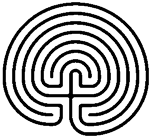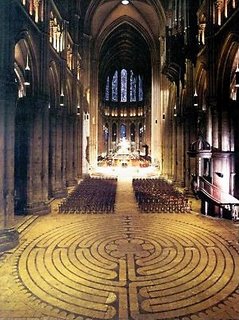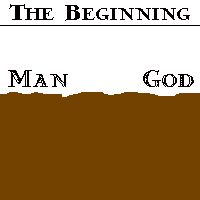Labyrinth is a means for prayer. Starting on the outside of the labyrinth, the praying person enters the labyrinth and prayerfully follows its winding paths to the centre. In the quiet, spiritual centre there is opportunity for rest, prayer, and preparation for the journey back to the world. For many walkers, the Labyrinth is a spiritual practice - for meditation, healing or insight. A labyrinth, unlike a maze, has no dead ends. There is only one path, and while it does have twists and turns, you can’t get lost. The same path takes you into the labyrinth and out again. With a labyrinth you don’t have to think, or analyze, or solve a problem. With a labyrinth you just trust that the path will lead you to where you need to be.
 The classical or seventh circuit labyrinth has seven circuits, referring the seven paths that lead to the center or goal. This is an ancient design and is found in most cultures. It is sometimes dated back more than 4000 years. Also known as the Cretan Labyrinth it is associated with the myth of Theseus and the Minotaur. This design was found on Cretan coins.
The classical or seventh circuit labyrinth has seven circuits, referring the seven paths that lead to the center or goal. This is an ancient design and is found in most cultures. It is sometimes dated back more than 4000 years. Also known as the Cretan Labyrinth it is associated with the myth of Theseus and the Minotaur. This design was found on Cretan coins.The classical labyrinth has an association with Christianity. A cross is the starting point used to construct this labyrinth. The cross at the center can become the focus for meditation and the experience of the labyrinth. The classical labyrinth design is found in many churches in Europe.
 The Middle Ages showed a renewed interest in labyrinths and a design more complex than the classical seven-circuit labyrinth became popular.
The Middle Ages showed a renewed interest in labyrinths and a design more complex than the classical seven-circuit labyrinth became popular.This was an eleven-circuit design divided into four quadrants. It was often found in Gothic Cathedrals but over time many of these eleven-circuit designs were destroyed or intentionally removed.
 The most famous of these remaining labyrinths is at Chartres Cathedral near Paris, France. The labyrinth at Chartres was built around 1200 and is laid into the floor in a style sometimes referred to as a pavement maze. The original center piece has been removed and other areas of the labyrinth have been restored.
The most famous of these remaining labyrinths is at Chartres Cathedral near Paris, France. The labyrinth at Chartres was built around 1200 and is laid into the floor in a style sometimes referred to as a pavement maze. The original center piece has been removed and other areas of the labyrinth have been restored.This labyrinth was meant to be walked but is reported to be infrequently used today. In the past it could be walked as a pilgrimage and/or for repentance. As a pilgrimage it was a questing, searching journey with the hope of becoming closer to God. When used for repentance the pilgrims would walk on their knees. Sometimes this eleven-circuit labyrinth would serve as a substitute for an actual pilgrimage to Jerusalem and as a result came to be called the "Chemin de Jerusalem" or Road of Jerusalem.
In walking the Chartres style labyrinth the walker meanders through each of the four quadrants several times before reaching the goal. An expectancy is created as to when the center will be reached. At the center is a rosette design which has a rich symbolic value including that of enlightenment. The four arms of the cross are readily visible and provide significant Christian symbolism.
Virtual walk of the labyrinth.



No comments:
Post a Comment